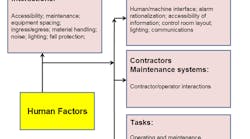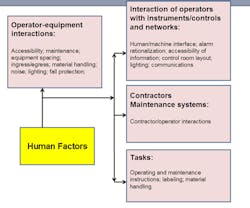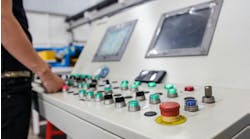Human error is a culprit in many industrial incidents, including some catastrophic events. Some safety experts suggest that human errors contribute to 60% to 70% or more of these incidents. However, some process hazard analyses (PHAs) pay scant attention to human factors — i.e., how workers interact with various aspects of running and managing operations. Equally troubling, human factors get barely any consideration during the design stage.
Until we reach the point where all processes are totally controlled by robots and artificial intelligence without any human involvement, operator interactions with equipment, instruments and controls, as well as other operators, will continue to play a pivotal part in minimizing safety mishaps. Indeed, operator interaction has prevented many unsafe events from becoming disasters.
Therefore, it’s crucial not just to realize that human faults continue to contribute to unsafe events but also to take steps to address such risks. This demands consideration of human factors in PHAs as well as design to minimize the possibility of human error.
Trouble Spots
Before we discuss the ways to augment human factor considerations in PHAs and design, consider the following:
• While best-in-class companies arrange multiple sessions during design and PHAs to discuss human factors, many other companies spend little time delving into human factors during a PHA.
• Although the U.S. Occupational Safety and Health Administration’s process safety management regulation requires human factors as a part of risk analysis (29 CFR 1910.119 (e) (3) (vi)), it lacks specificity. As a result, some companies regard human factors in a very narrow sense, such as equipment accessibility by an operator, limiting the breadth of discussion during design as well as a PHA.
• Many operating companies have laid off or otherwise lost experienced workers at plants. This robs new or relatively inexperienced operators of mentors. Proper training can address this issue to some extent. (See “Training Takes on an Added Dimension,” for some emerging developments.) Unfortunately, though, many plants have curtailed or eliminated training departments. So, effective operator training now is all too rare. Inadequate or improper training contributes to human error.
• In some cases, operating instructions aren’t clearly written. Human errors can occur because of poor instructions or poor understanding by operators or both.
• Today’s work force is substantially more diverse than that of 15 to 20 years ago. Language and cultural barriers could contribute to human errors. Safety managers and plant managers have the formidable task of ensuring that all operators and contractors have a clear unambiguous understanding of procedures.
• Many plants rely on legacy control systems that didn’t consider human factors adequately. As a result, the human/machine interface (HMI) displays aren’t easy to grasp quickly. In the event of an emergency, the legacy systems could delay effective response by an operator. (New control and information systems do consider human factors in design, e.g., for the HMI.)
Eight Key Points
Human factors pervade nearly all activities in running and maintaining a plant and, therefore, are multidisciplinary. Many regulations and guidelines are available (e.g., ASTM 1166 “Standard Practice for Human Engineering Design…,” NFPA 101 “Life Safety Code…,” OSHA 3124 “Stairways and Ladders,” and others on alarm management and rationalization, HMI design, labeling, etc.).
Figure 1. Human factors play an important role in ensuring safety in disparate plant activities.
Figure 1 depicts human factors from a systems’ viewpoint and highlights the four key aspects: operator/equipment interactions; operator interactions with instruments/controls and networks; contractor interactions; and tasks. It also notes specific factors that can impact safety in the event of an error. The bottom-line during design is to match systems with average human capabilities. To enhance the effectiveness of human factors assessment, consider eight key points.
1. At the strategic level, a safety professional or a PHA facilitator should evaluate the prevailing safety culture at your company. This could provide an opportunity to alert management to issues. Collect relevant data to show how human factors, or lack thereof, contributed to safety mishaps. Demonstrate that investment in human factors considerations (during design as well as a PHA) has an attractive return on investment. Get management’s buy-in.
2. With management’s buy-in, you now face a decision — whether to do human factors as a segment of a PHA or distinct from the PHA. Generally, the size of a project determines the choice. For relatively small projects (e.g., skid-mounted units, minor changes in process piping, instrumentation or equipment), include the human factors assessment as part of a hazards and operability (HAZOP) study. For large projects (e.g., pilot plants, new process units involving several operations or major capital investments), it’s usually best to perform human factors assessment separately from a regular PHA.
3. Small projects usually require only a single human factors assessment session. However, for large projects, it’s sensible to hold several sessions. Some topics to cover include equipment accessibility; operating/maintenance instructions; ingress/egress and escape routes; lighting; noise; stairs, ladders and platforms; crane operations; alarm management or rationalization; HMI design; control room layout and ergonomics; communications (especially in severe weather); and compliance with applicable regulations, standards and company guidelines. In addition, always consider possible impacts on human factors in other areas of the plant.
Divide each of the topics into several sections or nodes. For each node, delve into appropriate issues in detail. For instance, here are some questions to ponder regarding accessibility:
• Do the large valves have motor or hydraulic operators?
• Does getting to valves at high elevation require a platform?
• Should piping be re-routed so all valves are accessible?
• Should valves at very high elevation have chain operators? (However, some organizations avoid chain operators out of concern that a chain operator may not be able to guarantee that a valve is tightly closed when required.)
• Do maintenance people have adequate room to work?
• Are some valves so close to the ground that operators will have a hard time operating them?
• Are furnace burners’ and pilots’ fuel valves (which sometimes are under the furnace) safely accessible? In the event of unsafe conditions, can an operator quickly and safely exit from under the furnace? Is lighting sufficient?
• Can an operator do several things simultaneously when required — for instance, watch the level indicator on a drum while opening a valve?
• How accessible are drain valves on drip pans for large compressors or turbines?
• Are all sampling points easily accessible?
4. Factor-in generational and regional differences. For example, most-appropriate lighting, spacing and even furniture (chairs, desks) may differ from one generation to another. Similarly, the average size of people in the particular region of the world where the project is sited will influence, e.g., optimal chair and desk heights.
5. Incorporate the issues you’ve identified into a detailed questionnaire. Its focus should be to ensure adequate consideration of human factors so as to minimize the possibility of human error. You may use applicable standards, regulations and company guidelines in developing the questionnaire.
To enhance PHA effectiveness and efficiency, send the questionnaire to the participants well ahead of the sessions so they have adequate time to carefully review the questionnaire.
6. While a PHA offers an effective means to assess human factors, it doesn’t obviate attention to human factors during the design, procurement and installation stages. Consider holding several discussions with multidisciplinary teams during various design stages. Getting active participation from operators and maintenance personnel is important. Involve them in the PHA as well.
7. Seek active and open participation from contractors, too. But, first, as part of the selection/approval process, ensure the chosen contractor has a robust safety system and culture.
8. Consider holding several training sessions, preferably led by a human factors specialist, for professionals involved in design, procurement and construction.
Minimize Human Errors
Industry clearly must place greater emphasis on human factors to improve safety. Addressing human factors requires participation of multiple teams. Operators, maintenance personnel and contactors play vital roles in ensuring an effective human factors assessment. Also, give human factors an integral role when assessing adoption of new technologies.
GC SHAH, PE, is a senior consultant at Wood, Houston. E-mail him at [email protected].



